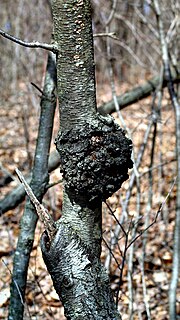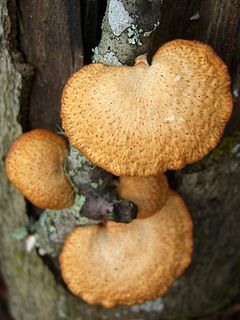
A truffle is the fruiting body of a subterranean ascomycete fungus, predominantly one of the many species of the genus Tuber. In addition to Tuber, many other genera of fungi are classified as truffles including Geopora, Peziza, Choiromyces, Leucangium, and over a hundred others. These genera belong to the class Pezizomycetes and the Pezizales order. There are several truffle-like basidiomycetes excluded from Pezizales including Rhizopogon and Glomus. Truffles are ectomycorrhizal fungi and are therefore usually found in close association with tree roots. Spore dispersal is accomplished through fungivores, animals that eat fungi. These fungi have significant ecological roles in nutrient cycling and drought tolerance.

The fungal order Agaricales, also known as gilled mushrooms or euagarics, contains some of the most familiar types of mushrooms. The order has 33 extant families, 413 genera, and over 13000 described species, along with six extinct genera known only from the fossil record. They range from the ubiquitous common mushroom to the deadly destroying angel and the hallucinogenic fly agaric to the bioluminescent jack-o-lantern mushroom.

The Boletales are an order of Agaricomycetes containing over 1300 species with a diverse array of fruiting body types. The boletes are the best known members of this group, and until recently, the Boletales were thought to only contain boletes. The Boletales are now known to contain distinct groups of agarics, gasteromycetes, and other fruiting-body types.

Cordyceps is a genus of ascomycete fungi that includes about 400 species. Most Cordyceps species are endoparasitoids, parasitic mainly on insects and other arthropods ; a few are parasitic on other fungi. The generic name Cordyceps is derived from the Greek word κορδύλη kordýlē, meaning "club", and the Latin word caput, meaning "head".

Black rot is a name used for various diseases of cultivated plants caused by fungi or bacteria, producing dark brown discoloration and decay in the leaves of fruit and vegetables:

The Clavulinaceae are a family of fungi in the order Cantharellales. The family is not well defined, but currently comprises species of clavarioid fungi as well as some corticioid fungi. These species are nutritionally diverse, some being ectomycorrhizal, others wood-rotting saprotrophs, others lichenized, and yet others lichenicolous.

Leccinum is a genus of fungi in the family Boletaceae. It was the name given first to a series of fungi within the genus Boletus, then erected as a new genus last century. Their main distinguishing feature is the small, rigid projections (scabers) that give a rough texture to their stalks. The genus name was coined from the Italian Leccino, for a type of rough-stemmed bolete. The genus has a widespread distribution, especially in north temperate regions, and contains about 75 species.

Helotiales is an order of the class Leotiomycetes within the division Ascomycota. According to a 2008 estimate, the order contains 10 families, 501 genera, and 3881 species.

Botryosphaeria dothidea is a plant pathogen that causes the formation of cankers on a wide variety of tree and shrub species. It has been reported on several hundred plant hosts and on all continents except Antarctica. B. dothidea was redefined in 2004, and some reports of its host range from prior to that time likely include species that have since been placed in another genus. Even so, B. dothidea has since been identified on a number of woody plants—including grape, mango, olive, eucalyptus, maple, and oak, among others—and is still expected to have a broad geographical distribution. While it is best known as a pathogen, the species has also been identified as an endophyte, existing in association with plant tissues on which disease symptoms were not observed. It can colonize some fruits, in addition to woody tissues.

Blastocladiomycota is one of the currently recognized phyla within the kingdom Fungi. Blastocladiomycota was originally the order Blastocladiales within the phylum Chytridiomycota until molecular and zoospore ultrastructural characters were used to demonstrate it was not monophyletic with Chytridiomycota. The order was first erected by Petersen for a single genus, Blastocladia, which was originally considered a member of the oomycetes. Accordingly, members of Blastocladiomycota are often referred to colloquially as "chytrids." However, some feel "chytrid" should refer only to members of Chytridiomycota. Thus, members of Blastocladiomyota are commonly called "blastoclads" by mycologists. Alternatively, members of Blastocladiomycota, Chytridiomycota, and Neocallimastigomycota lumped together as the zoosporic true fungi. Blastocladiomycota contains 5 families and approximately 12 genera. This early diverging branch of kingdom Fungi is the first to exhibit alternation of generations. As well, two (once) popular model organisms—Allomyces macrogynus and Blastocladiella emersonii—belong to this phylum.

Diaporthales is an order of sac fungi.

A fungus is any member of the group of eukaryotic organisms that includes microorganisms such as yeasts and molds, as well as the more familiar mushrooms. These organisms are classified as a kingdom, which is separate from the other eukaryotic life kingdoms of plants and animals.

The Helotiaceae are a family of fungi in the order Helotiales. The distribution of species in the family are widespread, and typically found in tropical areas. There are 117 genera and 826 species in the family.

Polyporus alveolaris, commonly known as the hexagonal-pored polypore, is a species of fungus in the genus Polyporus. It causes a white rot of dead hardwoods. Found on sticks and decaying logs, its distinguishing features are its yellowish to orange scaly cap, and the hexagonal or diamond-shaped pores. It is widely distributed in North America, and also found in Asia, Australia, and Europe.

Monilinia is a genus of fungi in the family Sclerotiniaceae.
The Hyponectriaceae are a family of fungi in the order Xylariales.
Trichosphaeria is a genus of fungi in the family Trichosphaeriaceae. There are about 25 species in this widespread genus, and they are typically found in woody habitats.

The corticioid fungi are a group of fungi in the Basidiomycota typically having effused, smooth basidiocarps that are formed on the undersides of dead tree trunks or branches. They are sometimes colloquially called crust fungi or patch fungi. Originally such fungi were referred to the genus Corticium and subsequently to the family Corticiaceae, but it is now known that all corticioid species are not necessarily closely related. The fact that they look similar is an example of convergent evolution. Since they are often studied as a group, it is convenient to retain the informal (non-taxonomic) name of "corticioid fungi" and this term is frequently used in research papers and other texts.

The hydnoid fungi are a group of fungi in the Basidiomycota with basidiocarps producing spores on pendant, tooth-like or spine-like projections. They are colloquially called tooth fungi. Originally such fungi were referred to the genus Hydnum, but it is now known that not all hydnoid species are closely related.
Benjamin Matlack Everhart was a United States mycologist.
















